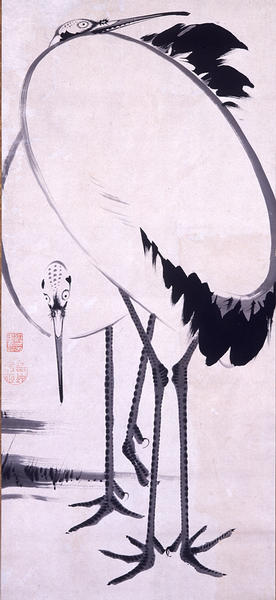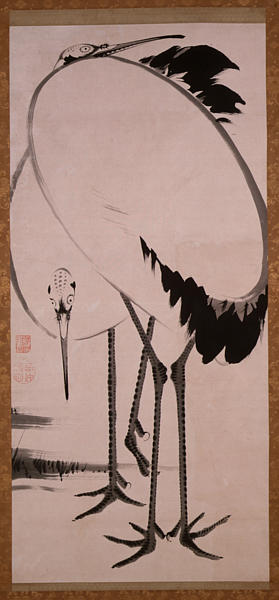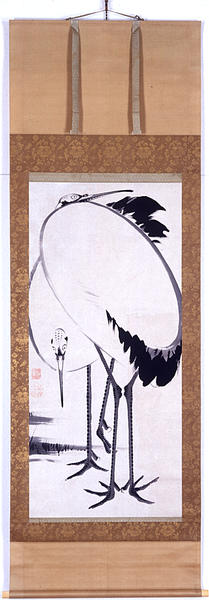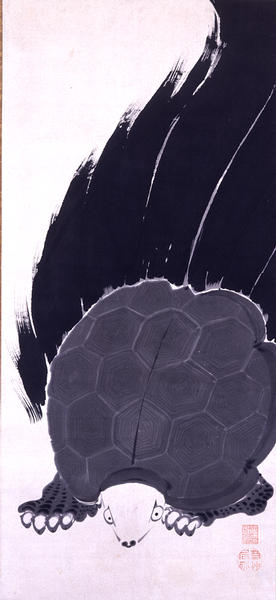Cranes, by Ito Jakuchu
- Edo period
- 18c
- Hanging scroll, ink on paper
- H-114.9 W-52.2
Catalogue Entry
Ito Jakuchu was born to a wholesale greengrocer in Nishikikoji in Kyoto. Jakuchu studied the style of the Kano school, and also studied paintings of Song, Yuan, and Ming dynasties in China. Realizing that he could not express himself fully by means of imitation alone, he eventually developed his own style of painting, by means of, in part, careful observation of nature. Jakuchu painted minutely detailed, decorative paintings of birds and flowers, as well as many unconventional ink paintings. As an aid to painting, he kept dozens of chickens loose in his yard, a practice that enabled him to observe and sketch them for years and produce a large number of works.
In the present ink paintings, two cranes and a tortoise believed to live in the sea off a mythical isle are placed diagonally, filling the space. Though extremely deformed, the paintings skillfully represent the animals' temperaments. In particular, the skills of Jakuchu as an accomplished realist are particularly evident in his handling of the egg-shaped bodies of cranes, one ducking its head, and in the carapace of the tortoise and the aquatic plants. Many of Jakuchu's ink paintings of animals and plants suggests a Zen-like ambiance, probably because he devoted himself to Zen Buddhism as a result of his friendship with Daiten, who would later become the chief priest of Shokokuji Temple in Kyoto, and because Jakuchu held within himself a reclusive personality. These personalities of Jakuchu are unmistakable in the look that these animals cast to the viewer as if to penetrate to the core of the viewer's soul.
Tortoise, by Ito Jakuchu
Catalogue Entry
Ito Jakuchu was born the son of a wholesale greengrocer in Nishikikoji in Kyoto. He first studied the Kano style of painting and investigated Chinese paintings from the Song, Yuan and Ming dynasties. He realized, however, that he could not express himself fully by means of imitation alone, and he moved beyond simple observation of nature to develop his own distinctive painting style. His huge oeuvre ranges from detailed, strongly decorative bird and flower paintings in full color to unconventional, buoyant ink paintings. Here Jakuchu has filled his compositions with diagonally opposing images of crane and tortoise. In spite of their highly deformed presentation, Jakuchu skillfully captures the essence of the animals depicted. Many of Jakuchu's ink paintings of animals and plants have a Zen‐like ambiance, and this tendency was firmly rooted in his devotion to Zen engendered by his interactions with Taiten, abbot of Shokokuji Temple in Kyoto and his naturally reclusive personality. Jakuchu's character is profoundly expressed in the piercing gaze of the tortoise and cranes, each seeming to look straight into the viewer's soul. The painting is impressed with an intaglio seal ,“藤女鈞印" and a relief seal , “若冲居士"
Tortoise, by Ito Jakuchu



